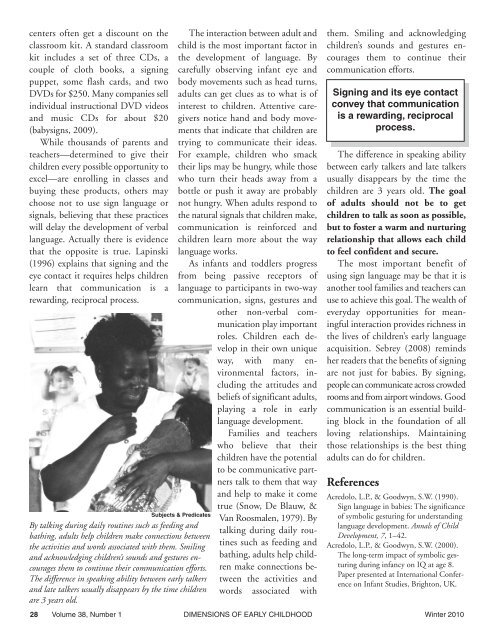90223 Dimensions Winter 10:Layout 1 - Southern Early Childhood ...
90223 Dimensions Winter 10:Layout 1 - Southern Early Childhood ...
90223 Dimensions Winter 10:Layout 1 - Southern Early Childhood ...
Create successful ePaper yourself
Turn your PDF publications into a flip-book with our unique Google optimized e-Paper software.
centers often get a discount on the<br />
classroom kit. A standard classroom<br />
kit includes a set of three CDs, a<br />
couple of cloth books, a signing<br />
puppet, some flash cards, and two<br />
DVDs for $250. Many companies sell<br />
individual instructional DVD videos<br />
and music CDs for about $20<br />
(babysigns, 2009).<br />
While thousands of parents and<br />
teachers—determined to give their<br />
children every possible opportunity to<br />
excel—are enrolling in classes and<br />
buying these products, others may<br />
choose not to use sign language or<br />
signals, believing that these practices<br />
will delay the development of verbal<br />
language. Actually there is evidence<br />
that the opposite is true. Lapinski<br />
(1996) explains that signing and the<br />
eye contact it requires helps children<br />
learn that communication is a<br />
rewarding, reciprocal process.<br />
Subjects & Predicates<br />
By talking during daily routines such as feeding and<br />
bathing, adults help children make connections between<br />
the activities and words associated with them. Smiling<br />
and acknowledging children’s sounds and gestures encourages<br />
them to continue their communication efforts.<br />
The difference in speaking ability between early talkers<br />
and late talkers usually disappears by the time children<br />
are 3 years old.<br />
The interaction between adult and<br />
child is the most important factor in<br />
the development of language. By<br />
carefully observing infant eye and<br />
body movements such as head turns,<br />
adults can get clues as to what is of<br />
interest to children. Attentive caregivers<br />
notice hand and body movements<br />
that indicate that children are<br />
trying to communicate their ideas.<br />
For example, children who smack<br />
their lips may be hungry, while those<br />
who turn their heads away from a<br />
bottle or push it away are probably<br />
not hungry. When adults respond to<br />
the natural signals that children make,<br />
communication is reinforced and<br />
children learn more about the way<br />
language works.<br />
As infants and toddlers progress<br />
from being passive receptors of<br />
language to participants in two-way<br />
communication, signs, gestures and<br />
other non-verbal communication<br />
play important<br />
roles. Children each develop<br />
in their own unique<br />
way, with many environmental<br />
factors, including<br />
the attitudes and<br />
beliefs of significant adults,<br />
playing a role in early<br />
language development.<br />
Families and teachers<br />
who believe that their<br />
children have the potential<br />
to be communicative partners<br />
talk to them that way<br />
and help to make it come<br />
true (Snow, De Blauw, &<br />
Van Roosmalen, 1979). By<br />
talking during daily routines<br />
such as feeding and<br />
bathing, adults help children<br />
make connections between<br />
the activities and<br />
words associated with<br />
them. Smiling and acknowledging<br />
children’s sounds and gestures encourages<br />
them to continue their<br />
communication efforts.<br />
Signing and its eye contact<br />
convey that communication<br />
is a rewarding, reciprocal<br />
process.<br />
The difference in speaking ability<br />
between early talkers and late talkers<br />
usually disappears by the time the<br />
children are 3 years old. The goal<br />
of adults should not be to get<br />
children to talk as soon as possible,<br />
but to foster a warm and nurturing<br />
relationship that allows each child<br />
to feel confident and secure.<br />
The most important benefit of<br />
using sign language may be that it is<br />
another tool families and teachers can<br />
use to achieve this goal. The wealth of<br />
everyday opportunities for meaningful<br />
interaction provides richness in<br />
the lives of children’s early language<br />
acquisition. Sebrey (2008) reminds<br />
her readers that the benefits of signing<br />
are not just for babies. By signing,<br />
people can communicate across crowded<br />
rooms and from airport windows. Good<br />
communication is an essential building<br />
block in the foundation of all<br />
loving relationships. Maintaining<br />
those relationships is the best thing<br />
adults can do for children.<br />
References<br />
Acredolo, L.P., & Goodwyn, S.W. (1990).<br />
Sign language in babies: The significance<br />
of symbolic gesturing for understanding<br />
language development. Annals of Child<br />
Development, 7, 1–42.<br />
Acredolo, L.P., & Goodwyn, S.W. (2000).<br />
The long-term impact of symbolic gesturing<br />
during infancy on IQ at age 8.<br />
Paper presented at International Conference<br />
on Infant Studies, Brighton, UK.<br />
28 Volume 38, Number 1 DIMENSIONS OF EARLY CHILDHOOD <strong>Winter</strong> 20<strong>10</strong>
















